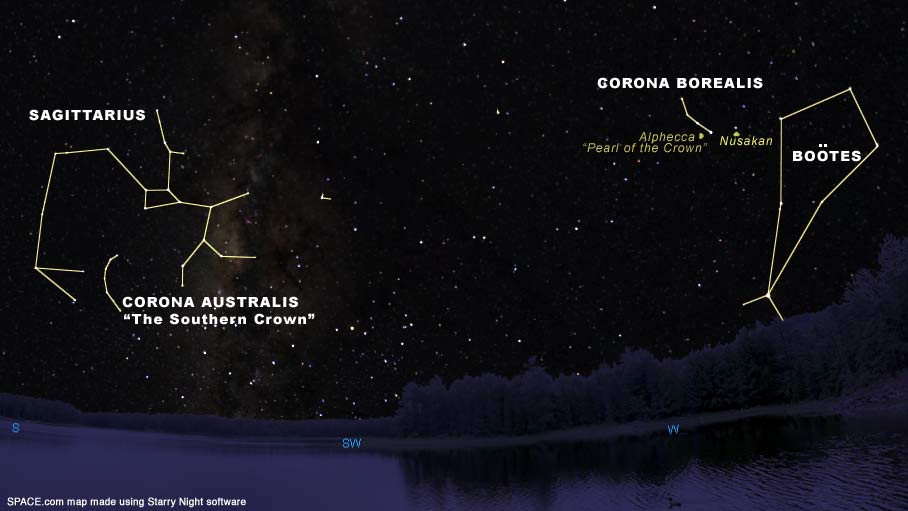
There is a rather striking star pattern situated low in the south after darkness falls, which I briefly mentioned last week in our discussion of Sagittarius: Corona Australis, the Southern Crown. Now would be a very good time to make comparisons with its northern counterpart, Corona Borealis, located high in the west.
The main difference between the two is that the southern one is a fainter and tighter pattern; its brightest members are only of 4th magnitude. The brightest star of Corona Borealis, on the other hand, is 2nd-magnitude Alphecca, also known as Gemma, the "gem" or the "Pearl of the Crown" in the middle of the bow.
Unfortunately, for most of the United States, Corona Australis is quite close to the horizon; from New York City it barely gets 10 degrees above the horizon, where horizon haze becomes significant. One really has to go as far south as Florida or the Gulf Coast to get a really good view of it.
Both crowns are ancient constellations, part of Claudius Ptolemy's (87-150 AD?) "definitive" list of 48 groupings that were handed down to Western peoples from that era.
Corona Borealis is a small but graceful star-pattern, just off to the east of Boötes, the Herdsman. In the sky it actually looks more like a tiara. For many years, I always enjoyed pointing out the Northern Crown to planetarium audiences during the month of September, commenting that it looked very much like the crown presented to the winner of the annual Miss America Pageant. But since the pageant has now been moved to January, I have to be a little more creative and point out some other interesting facts about the Crown on early September evenings.
This beautiful little circlet of stars is only a momentary formation, for the stars are moving helter-skelter in different directions. Alphecca and Nusakan, a star immediately adjacent to it, have opposing motions and, in the past 75,000 years have just about changed places.
Another rather amazing feature about the Northern Crown is that within its boundaries there is a very rich cluster of distant galaxies, referred to as a supergalaxy. It is one of the most remarkable of all such aggregations, with more than 400 galaxies. The cluster is extremely remote; estimates place it at 1.3 billion light-years and receding from us at 13,000 miles per second or about one-fourteenth the velocity of light.
Get the Space.com Newsletter
Breaking space news, the latest updates on rocket launches, skywatching events and more!
Corona Borealis is the gem-studded golden crown of Ariadne, who, in Greek legend, received it from Bacchus upon marrying him. The much dimmer Corona Australis, however, represented a crown of leaves sometimes worn by the ancients on ceremonial occasions. It has no particular story associated with it, although some write that it was another crown that Bacchus gave as a gift, this one to his mother Semele.
Basic Sky Guides
- Full Moon Fever
- Astrophotography 101
- Sky Calendar & Moon Phases
- 10 Steps to Rewarding Stargazing
- Understanding the Ecliptic and the Zodiac
- False Dawn: All about the Zodiacal Light
- Reading Weather in the Sun, Moon and Stars
- How and Why the Night Sky Changes with the Seasons
- Night Sky Main Page: More Skywatching News & Features


Joe Rao serves as an instructor and guest lecturer at New York's Hayden Planetarium. He writes about astronomy for The New York Times and other publications, and he is also an on-camera meteorologist for News 12 Westchester, New York.
| DEFINITIONS |
1 AU, or astronomical unit, is the distance from the Sun to Earth, or about 93 million miles. Magnitude is the standard by which astronomers measure the apparent brightness of objects that appear in the sky. The lower the number, the brighter the object. The brightest stars in the sky are categorized as zero or first magnitude. Negative magnitudes are reserved for the most brilliant objects: the brightest star is Sirius (-1.4); the full Moon is -12.7; the Sun is -26.7. The faintest stars visible under dark skies are around +6. Degrees measure apparent sizes of objects or distances in the sky, as seen from our vantage point. The Moon is one-half degree in width. The width of your fist held at arm's length is about 10 degrees. The distance from the horizon to the overhead point (called the zenith) is equal to 90 degrees. Declination is the angular distance measured in degrees, of a celestial body north or south of the celestial equator. If, for an example, a certain star is said to have a declination of +20 degrees, it is located 20 degrees north of the celestial equator. Declination is to a celestial globe as latitude is to a terrestrial globe. Arc seconds are sometimes used to define the measurement of a sky object's angular diameter. One degree is equal to 60 arc minutes. One arc minute is equal to 60 arc seconds. The Moon appears (on average), one half-degree across, or 30 arc minutes, or 1800 arc seconds. If the disk of Mars is 20 arc seconds across, we can also say that it is 1/90 the apparent width of the Moon (since 1800 divided by 20 equals 90). |
Join our Space Forums to keep talking space on the latest missions, night sky and more! And if you have a news tip, correction or comment, let us know at: community@space.com.

Joe Rao is Space.com's skywatching columnist, as well as a veteran meteorologist and eclipse chaser who also serves as an instructor and guest lecturer at New York's Hayden Planetarium. He writes about astronomy for Natural History magazine, Sky & Telescope and other publications. Joe is an 8-time Emmy-nominated meteorologist who served the Putnam Valley region of New York for over 21 years. You can find him on Twitter and YouTube tracking lunar and solar eclipses, meteor showers and more. To find out Joe's latest project, visit him on Twitter.









